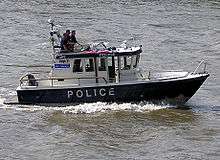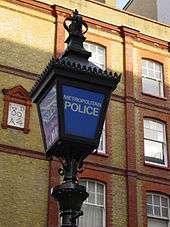Metropolitan Police Marine Policing Unit

The Marine Policing Unit (MPU), formally known as Thames Division, is a Central Operations (CO) branch of London's Metropolitan Police Service. Its forerunner, the Marine Police Force, was England's first recognised preventive police unit.
The MPU is headquartered on Wapping High Street, in the east of the city, from where it operates a fleet of vessels responsible for policing the River Thames within Greater London.
History

Thames Division was formed in 1839 when the Marine Police Force was absorbed into the Metropolitan Police Force. The original marine force is considered the first preventive police unit in the history of policing in England. It began when a merchant and magistrate, Patrick Colquhoun, teamed up with mariner John Harriott and Jeremy Bentham to persuade shipping companies to finance a police force to prevent the theft of cargo from London's docks. The first death of an officer in the line of duty occurred shortly thereafter, when Gabriel Franks was killed in a skirmish with dock workers protesting against the new force.[1] Impressed by the economic impact of the initiative, the government passed the Marine Police Bill on 28 July 1800, making it one of the first publicly funded police forces, and also the first uniformed police force in the world.[2]
Initially, patrols were conducted in rowing boats, some of which remained in use until 1905. Impetus to change was provided when, on 3 September 1878, the steam collier Bywell Castle ran into the pleasure steamer Princess Alice in Galleons Reach, resulting in the loss of over 600 lives. The subsequent inquest and inquiry recommended that Thames Division should have steam launches, as rowing galleys had shown themselves to be inadequate for police duty, and the first two were commissioned in the mid-1880s. In 1910 the first motor vessels were introduced.[3]
Initially operating out of Wapping Police Station (since 1798, the current building having been rebuilt in 1907[4]), a second station was built further east at Blackwall. Using land freed up from the General Steam Navigation Company's cattle wharf at Coldharbour, a three storey building comprising cells, accommodation and a boat-launch was constructed in 1893. Due to the decline of the docks at Canary Wharf in the late 20th century, the Blackwall River Police Station was closed in the 1970s and converted to residential properties in 1982.[5] In November 1978, Thames Division became a specialist unit under the direct command of Assistant Commissioner "A".
On 20 August 1989 the Marchioness disaster occurred when an aggregate dredger, the Bowbelle, collided with a passenger vessel, the Marchioness, near Cannon Street Railway Bridge. Four police patrol boats assisted in the rescue of 87 people. Fifty-one passengers died, though, and following subsequent inquiries the government asked the Maritime and Coastguard Agency, the Port of London Authority and the Royal National Lifeboat Institution to work together to set up a dedicated search and rescue service for the tidal River Thames. Consequently, on 2 January 2002, the RNLI set up four lifeboat stations at Gravesend, Tower Pier, Chiswick Pier and Teddington, taking over the role of primary search and rescue service on the river from Thames Division.
In 2001, Thames Division was renamed the Marine Support Unit, and again in 2008 as the Marine Policing Unit.
Contemporary role
Today the MPU is responsible for waterborne policing of the 47 miles of the Thames between Hampton Court in the west and Dartford Creek in the east. Above Hampton Court, Surrey Police have responsibility for policing but a launch is supplied by the Environment Agency. Below Dartford Creek, responsibility lies with both Essex Police and Kent Police, who have combined forces and formed a joint marine unit, with Kent based at Sheerness and Essex based at Burnham-on-Crouch.
Based at a police station on Wapping High Street and with 22 vessels at its disposal, the MPU also provides support to the rest of the Metropolitan Police and to the City of London Police when dealing with incidents in or around any waterway in London. A specialist underwater and confined-spaces search team carries out searches throughout the Metropolitan Police District. The unit also has 24 officers who are trained in rope access techniques and trained to carry out searches and counter demonstrator operations at height.
References
- ↑ Dick Paterson, "Thames Police History - The Police Establishment," Thames Police Museum. Retrieved 7 February 2007.
- ↑ Dick Paterson, "Thames Police History - Government Sponsorship," Thames Police Museum. Retrieved 7 February 2007.
- ↑ History of the Marine Support Unit accessed 7 Feb 2007 Archived 16 July 2007 at the Wayback Machine.
- ↑ http://content.met.police.uk/Article/Where-we-work/1400017893590/1400017893590
- ↑ http://www.british-history.ac.uk/survey-london/vols43-4/pp607-624#p73
